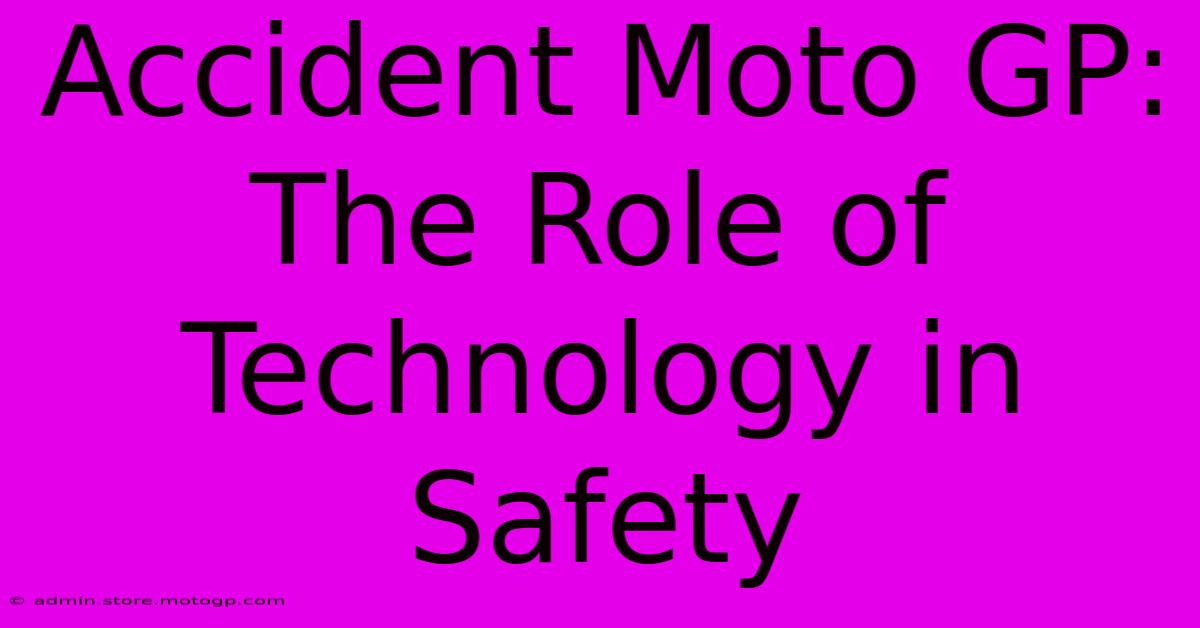Accident Moto GP: The Role Of Technology In Safety

Table of Contents
Accident Moto GP: The Role of Technology in Safety
MotoGP, the pinnacle of motorcycle racing, is a thrilling spectacle of speed, skill, and daring. However, the inherent risks are undeniable. High speeds and close-quarters racing inevitably lead to accidents. While rider skill and track conditions play significant roles, technological advancements have become increasingly crucial in mitigating the dangers and enhancing rider safety. This article explores the vital role technology plays in minimizing the impact of MotoGP accidents.
The Evolution of Safety Technology in MotoGP
The history of MotoGP safety is a testament to continuous innovation. From basic improvements in track design and rider leathers to sophisticated electronic systems, the sport has witnessed a dramatic shift towards enhanced protection.
Early Innovations:
- Track improvements: The introduction of improved track designs, including wider run-off areas and safer barriers (e.g., Tecpro barriers), significantly reduced the severity of impacts.
- Rider apparel: The evolution of protective gear, including advanced leathers, helmets with improved impact absorption, and specialized boots and gloves, has dramatically reduced rider injuries.
Modern Technological Advancements:
The most significant advancements have been in electronic systems designed to improve both rider control and track safety:
- Electronic control units (ECUs): Modern MotoGP bikes utilize sophisticated ECUs that manage various aspects of engine performance, traction control, wheelie control, and anti-lock braking systems (ABS). These systems enhance rider control and prevent loss of traction, reducing the risk of crashes.
- Traction control: This technology prevents the rear wheel from spinning uncontrollably, providing more stability, especially in slippery conditions.
- Wheelie control: This helps prevent the front wheel from lifting off the ground, maintaining stability and control, especially during acceleration.
- Anti-lock braking system (ABS): Prevents the wheels from locking up during braking, allowing for more controlled stopping and reducing the chance of a high-side crash.
- Airbags: Integrated into racing suits, airbags inflate instantly upon impact, further cushioning the rider and minimizing injuries.
- Telemetry and data analysis: Extensive data collected during races provides valuable insights into rider performance and the dynamics of crashes, helping engineers and riders fine-tune safety features and improve riding techniques.
The Impact of Technology on Accident Severity
Technological advancements have demonstrably reduced the severity of accidents in MotoGP. While crashes are still unavoidable, the consequences are often far less severe than they were in the past. The introduction of sophisticated safety features has resulted in:
- Fewer fatalities: The number of fatal accidents in MotoGP has significantly decreased over the years, thanks to continuous safety improvements.
- Reduced severity of injuries: While injuries remain a possibility, the severity is often less critical due to the enhanced protection offered by modern technology and safety equipment.
- Faster recovery times: Improved medical care and enhanced protection help riders recover faster from injuries, allowing them to return to racing sooner.
Ongoing Research and Future Developments
The pursuit of greater safety in MotoGP is a continuous process. Ongoing research focuses on:
- Advanced materials: Developing lighter, stronger, and more protective materials for rider apparel and motorcycle components.
- Artificial intelligence (AI): Exploring the potential of AI to enhance predictive analysis of potential accidents and improve safety systems.
- Improved data analysis: Refining techniques to better understand accident dynamics and develop more effective safety measures.
- Further refinements to electronic control systems: Constantly upgrading and enhancing electronic control systems to provide more effective rider assistance and safety nets.
Conclusion
Technology plays an indispensable role in ensuring rider safety in the high-stakes world of MotoGP. From track design and rider apparel to sophisticated electronic systems, constant innovation has significantly reduced the severity and frequency of accidents. While the risks inherent in the sport remain, the ongoing development and implementation of safety technology continue to make MotoGP a safer and more controlled environment for the world's best motorcycle racers. The relentless pursuit of enhanced safety underscores the commitment to protecting these athletes while preserving the thrill and excitement of this demanding sport.

Thank you for visiting our website wich cover about Accident Moto GP: The Role Of Technology In Safety. We hope the information provided has been useful to you. Feel free to contact us if you have any questions or need further assistance. See you next time and dont miss to bookmark.
Featured Posts
-
Get Your Adrenaline Pumping Austin Gp Sprint Race Rush
Feb 19, 2025
-
Get Your Cota Fix Shop Now
Feb 19, 2025
-
Lot F Your Circuit Of The Americas Parking Companion
Feb 19, 2025
-
F1 Shuttle Service The Ultimate Race Day Upgrade
Feb 19, 2025
-
The Legacy Of The Best Moto Gp Rider
Feb 19, 2025
